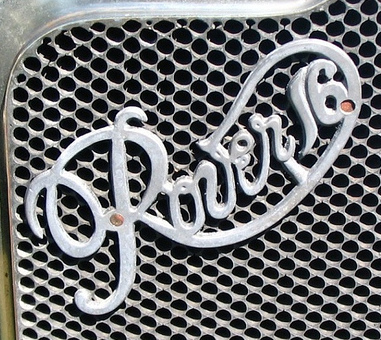
ROVER 14/45hp and 16/50hp
Complicated, slow and too expensive
1924 - 1928
The ROVER 14/45hp - later the ROVER 16/50hp - replace the well-tried 'Clegg' 14hp, but do not reach the reliable reputation of the latter. The picture of the five-seater 14/45hp Tourer is taken from a ROVER advertisement from 1924.
Predecessor
Supplement
ROVER 16/50hp
Successor

16/50 hp Radiator-Logo
With the 14/45 hp, ROVER puts a very solid car on its wheels, innovatively designed in many parts, elaborately built and very solid. Especially the rather complicated engine is very complex in production - and it does not meet the expectations. The fuel consumption is comparatively high, the valve train is complicated and not as quiet as expected and - this is probably the biggest dilemma - its reliability is measured against its predecessor 12hp / 14hp "Clegg", which had proven itself since 1911.
In all tests of the serial models 14/45 hp and 16/50 hp the low top speed (and the arduous way to reach it) is criticized. However, thanks to the transmission gradation, both models are good hill climbers.
The complex engine, the very solid chassis and the - at that time not yet common - four-wheel brakes are highly praised. The fact that this also costs something is reflected in the initially high prices. Until the end of the construction period, poor sales figures and the high competitive pressure caused considerable price reductions.
Peter August Poppe, chief designer at Rover, had invested over eight years of development time in the construction of the 14/45 hp. The well thought-out and innovative machine bears witness to this in many details. The technical editors of the motoring media are very pleased - but comparatively high fuel consumption and slow speed, even with the improved 16/50 hp - do not satisfy the customers.
Dudley Noble, ROVER's busy advertising and PR manager, has his hands full to ensure that the car's image does not damage the overall image of Rover. He uses the car's good "hill climber" genes to tackle the fifty-fold ascent and descent of the infamous Bwlch-y-Groes in North Wales. With this ROVER wins the coveted "Dewar" Trophy of the R.A.C., which can also be used for advertising purposes. He then organised the construction of the "Odin" racing cars, which, with tuned 16/50 hp engines and modified chassis, achieved good results in some Brooklands races. Two race car bodies are known. In addition to that, pictures of the 14/45 hp and 16/50 hp with short texts are interspersed in the editorial parts of newspapers and magazines.
All in all, it can be said that the two models cause ROVER, not least because of warranty services, quite financial difficulties; the numbers of cars remain small, altogether only about 3000 14/45 hp and 2500 16/50 hp were built. A successor is eagerly awaited.
| Sources | |
|---|---|
 | Brochure "Rover Cars 1926" 14/45 h.p. + 16/50 h.p. late 1925 / early 1926 |
 | Rover Enthusiast Magazine James Taylor November 2007 |
© 2021-2026 by ROVER - Passion / Michael-Peter Börsig

 Deutsch
Deutsch